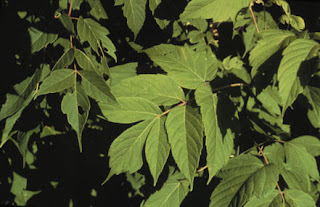 |
| Boxelder bug - web photo |
Totally
innocent might be a stretch although Boxelder bugs don’t do any real harm to
humans.
Since
we live in an area where there is both heat and cold most insect populations
ebb and flow over time. Live long enough
and nature will provide a natural predator for most insects. We just hope it comes in time to save what
they’re attacking.
Boxelder
bugs “Boisea trivittatus” only become a nuisance because they seek the shelter
of your home when the weather turns cool.
The best way to keep this from happening is have a home with no insect entry
points – good luck if you own an older home.
It’s basically the same method used to keep cold air from entering your
home through cracks and holes.
There
is a chemical spray for the outside of buildings that may be used but it seems
like sending the Marines in to swat a fly.
Some have good luck spraying with a soap solution. This must come in direct contact with the insect. (One tablespoon dish washing liquid to one
cup water.) Electronic attraction
devices do not work on Boxelder bugs.
Once
the Boxelder is inside, the best “control” and I use that word control loosely,
is to vacuum or sweep them up. They
don’t reproduce inside. Spraying
insecticides inside the house doesn’t help.
You might try spreading Vaseline on piece of white poster board and
putting on a sunny window sill.
Apparently, they get stuck and then you discard the whole mess.
The
insects feed in the spring on the seeds of female “Acer” trees and prefer the
Boxelder. Removing these trees from your
property doesn’t deter the insects since they can fly miles for food. The value of maple trees outweighs the
benefit of removing. The insects are not
considered an agricultural pest.
I
have found no evidence Boxelder insects cause human health hazards.
Boxelder
infestations are not large every year. 2012
was the perfect Boxelder breeding year:
A warm wet spring followed by a hot, dry summer. On the flip side, it was not a good year for
Asian Beetles.
It
is predicted the hot dry summer was also not good for Japanese Beetles as they
couldn’t get far enough into the earth to reproduce. I can only hope!
 |
| Boxelder leaves - web photo |
On
an extended information highway, the Boxelder tree is truly an “Acer” and that
means it’s a Maple tree. It’s native to
North America. It’s the only North
American tree with compound leaves.
(Remember that one if you’re into trivia!) The seed heads look like “helicopters” of
other maple trees. They must have a male
and female tree to reproduce but those little helicopters are both very
prolific and fertile.
Several
birds and squirrels eat the seedpods and the Evening Grosbeck eats the seeds
exclusively. (You may thank me now for
filling your trivia information gap!)
The
only commercial uses outside of the landscape is using in fiberboard and wood
turning. It’s a fast growing weak tree
and considered invasive in some parts of the world. Flutes excavated from what is now
Northeastern Arizona dated to 600 AD were made of this tree.
Today
I can count my Blessings the Boxelder bug isn’t a big deal. And, that is just the small when I think what
Blessings I have to be thankful for this coming Thanksgiving. A God who owes me nothing but gives me
everything, family and friends, the drought is lessening and the garden is put
to sleep for the winter. Wishing you and
yours a Blessed Thanksgiving, too.
 |
| Thankful for this beautiful sunrise. |
No comments:
Post a Comment